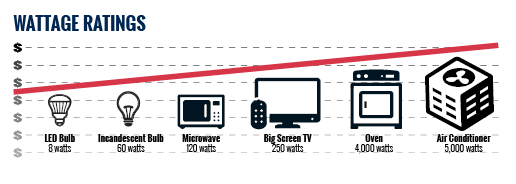This past month, United Power announced a new line item would be appearing on member electric bills to prepare them for a new rate structure taking effect next year. The new line item, a Demand Charge, will not have a cost associated immediately, but will show the member’s highest usage interval in kilowatts (kW) from the previous month. The Demand Charge line item is appearing on bills now with no charge to give members an opportunity to understand how this new rate can help them better manage their energy costs.
Members on the standard residential rate are very familiar with total energy used, which is billed in kilowatt-hours (kWh). But the new residential demand rate will also measure the power, or demand component of electricity consumption, which is measured in kilowatts (kW). This demand component is something that many customers are less familiar with, so let’s talk about “watt” drives your demand.
Demand is measured in kilowatts (kW). One kilowatt equals 1,000 watts, which is the equivalent of turning on ten 100-watt light bulbs at once. Understanding the wattage of your household appliances will help you take control of your energy bill, but where can you learn more about this information?
Common wattage ratings can be found online, or by using tools like a Kill-A-Watt monitor. Below are some sample wattage ratings for common household appliances. Remember: the larger the wattage of an appliance, and the more appliances you operate at once, the higher the impact it can have on the energy usage and demand on your overall electric bill.
Now is the time to pay attention to your energy use patterns. Staggering the use of higher wattage appliances will be the easiest way to manage your electric bill under the new rate structure. How many appliances do you run at once? Do you come home and turn everything on after the house has been empty all day? Are you using technology to help you remember to offset energy use like timers, delay start settings and programmable thermostats? Focusing on how you’re using your household appliances will help you see the corresponding affect to your energy and demand, and United Power’s new Demand rate will put you in the driver’s seat of your electric bill.


